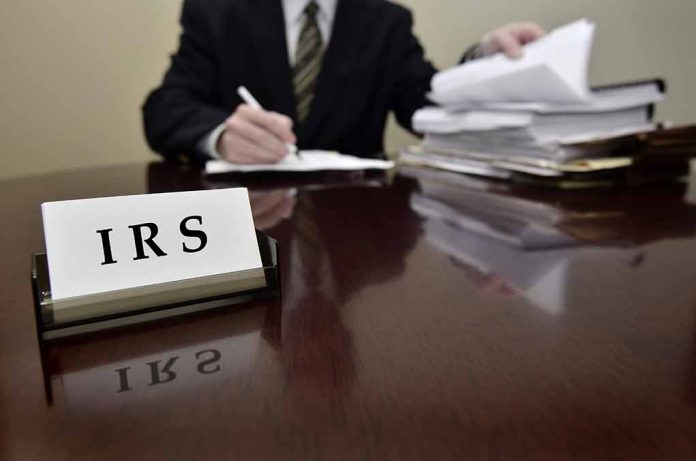
The Supreme Court delivered a decisive victory for the IRS in a bankruptcy dispute, ruling 8-1 that the tax agency’s sovereign immunity shields it from returning potentially fraudulent payments made beyond standard lookback periods.
Key Takeaways
- The Supreme Court upheld IRS sovereign immunity in an 8-1 decision, preventing bankruptcy trustees from recovering payments made to the agency beyond the standard two-year period.
- Justice Ketanji Brown Jackson wrote that sovereign immunity waivers are jurisdictional and don’t create new substantive rights against the government.
- The case involved $145,000 transferred to the IRS by All Resort Group Inc. three years before bankruptcy to cover its principals’ personal tax liabilities.
- The ruling resolves a split among federal appeals courts on bankruptcy trustees’ powers to recover funds paid to government entities.
- Justice Neil Gorsuch issued the lone dissent, challenging the majority’s interpretation of sovereign immunity provisions.
Supreme Court Reinforces IRS Protections in Bankruptcy
In a ruling with significant implications for bankruptcy proceedings involving government entities, the Supreme Court has firmly established that the Internal Revenue Service possesses sovereign immunity that prevents bankruptcy trustees from clawing back certain payments. The decision in United States v. Miller saw the Court reverse the 10th Circuit Court’s ruling, determining that federal bankruptcy law does not override the government’s sovereign immunity when trustees attempt to recover potentially fraudulent transfers using state law provisions.
🚨 SCOTUS Just Gave the IRS a Free Pass to Keep Stolen Money~Even if It Came from You 🚨
The Supreme Court just ruled on 26 March, 2025~8-1 in United States v. Miller that if someone steals money from you or your business and uses it to pay their IRS tax debt, the IRS gets to… pic.twitter.com/D6Wg5HxtfI
— 💅🏻💋qubit💋💅🏻#FlynnFramedTrump‼️ (@qubitTwit) March 27, 2025
The case centered on a $145,000 payment made by All Resort Group Inc. to the IRS three years before the company filed for bankruptcy. The funds were used to satisfy the personal tax obligations of the company’s principals rather than corporate tax liabilities, a transaction later deemed potentially fraudulent under Utah state law. When the bankruptcy trustee attempted to recover these funds, the question became whether sovereign immunity shielded the IRS from such actions.
Legal Framework and Court’s Reasoning
Writing for the majority, Justice Ketanji Brown Jackson explained the complex interplay between bankruptcy law and sovereign immunity. The Court emphasized that Section 544(b) of the Bankruptcy Code allows trustees to avoid transfers that an unsecured creditor could void under applicable state law. However, the critical question was whether the sovereign immunity waiver in Section 106(a) of the Bankruptcy Code extended to state law claims that form the basis for Section 544(b) actions. “Waivers of sovereign immunity are jurisdictional provisions that empower courts to hear claims against the government but do not themselves typically create any new substantive rights against the government,” wrote Justice Jackson.
The Court’s 8-1 decision concluded that while Section 106(a) waives sovereign immunity for the federal bankruptcy claim itself, it does not extend this waiver to the underlying state law claims. This interpretation effectively means that bankruptcy trustees cannot use state fraudulent transfer laws to recover payments made to the IRS beyond the standard two-year lookback period established in federal bankruptcy law.
Practical Implications for Bankruptcy Proceedings
This ruling resolves a significant split among federal appeals courts. The Fourth, Ninth, and Tenth Circuits had previously rejected the Seventh Circuit’s approach, creating uncertainty regarding trustees’ powers to recover government payments. Now, bankruptcy trustees face clear limitations on their ability to void transfers to government entities using state fraudulent transfer laws, which typically have longer lookback periods than federal bankruptcy provisions.
The decision highlights the Court’s commitment to strictly construing sovereign immunity waivers, resolving ambiguities in favor of the government. For bankruptcy practitioners, this reinforces the need to consider alternative approaches when seeking to recover funds paid to government entities.
Dissenting View and Future Considerations
Justice Neil Gorsuch provided the lone dissent, challenging the majority’s interpretation of the sovereign immunity provisions in the Bankruptcy Code. His dissent suggests that questions remain about the proper balance between bankruptcy law’s goal of equitable distribution among creditors and the government’s sovereign immunity protections.
While the ruling limits trustees’ options under Section 544(b), bankruptcy practitioners note that single asset debtors might still pursue recovery using Section 550 of the bankruptcy code, which allows for the waiver of sovereign immunity and disgorgement of funds under different legal theories. This suggests that creative legal strategies may develop to address the challenges presented by this decision, as trustees seek to fulfill their duty to maximize recovery for creditors while navigating the strengthened sovereign immunity protections now afforded to government entities like the IRS.
Sources:
Supreme Court Hands IRS Win Over Bankruptcy Trustee Clawback (3)
Supreme Court Reverses Bankruptcy Tax Clawback Decision
SCOTUS Sides With IRS In Bankruptcy Dispute



